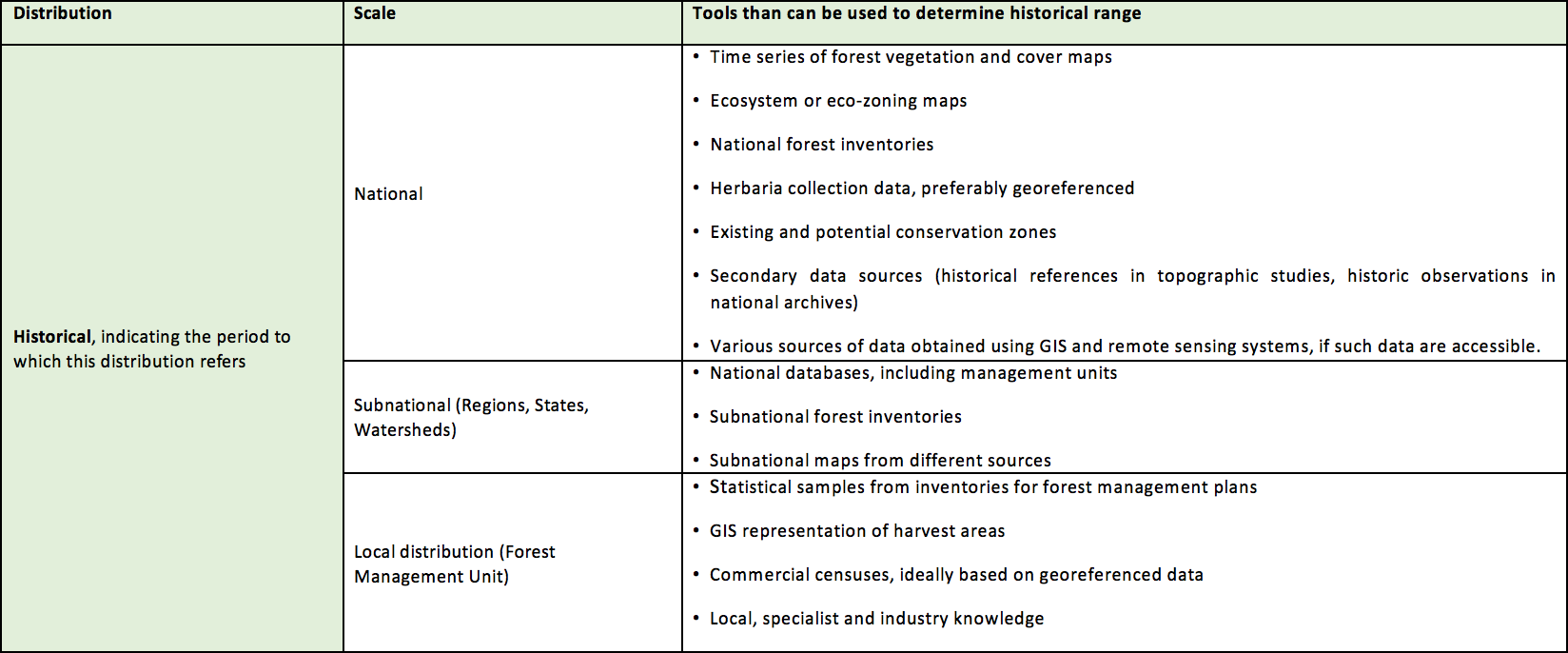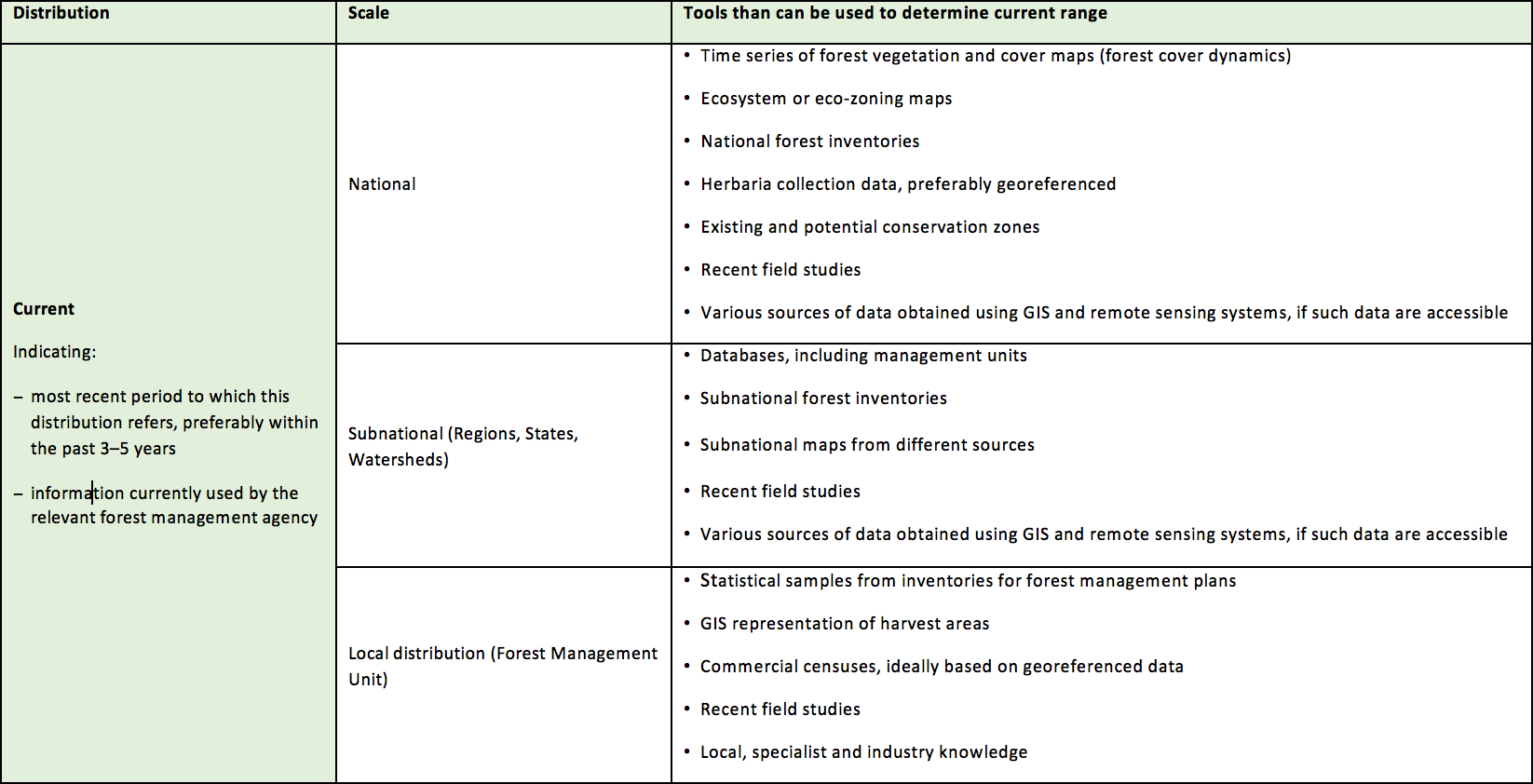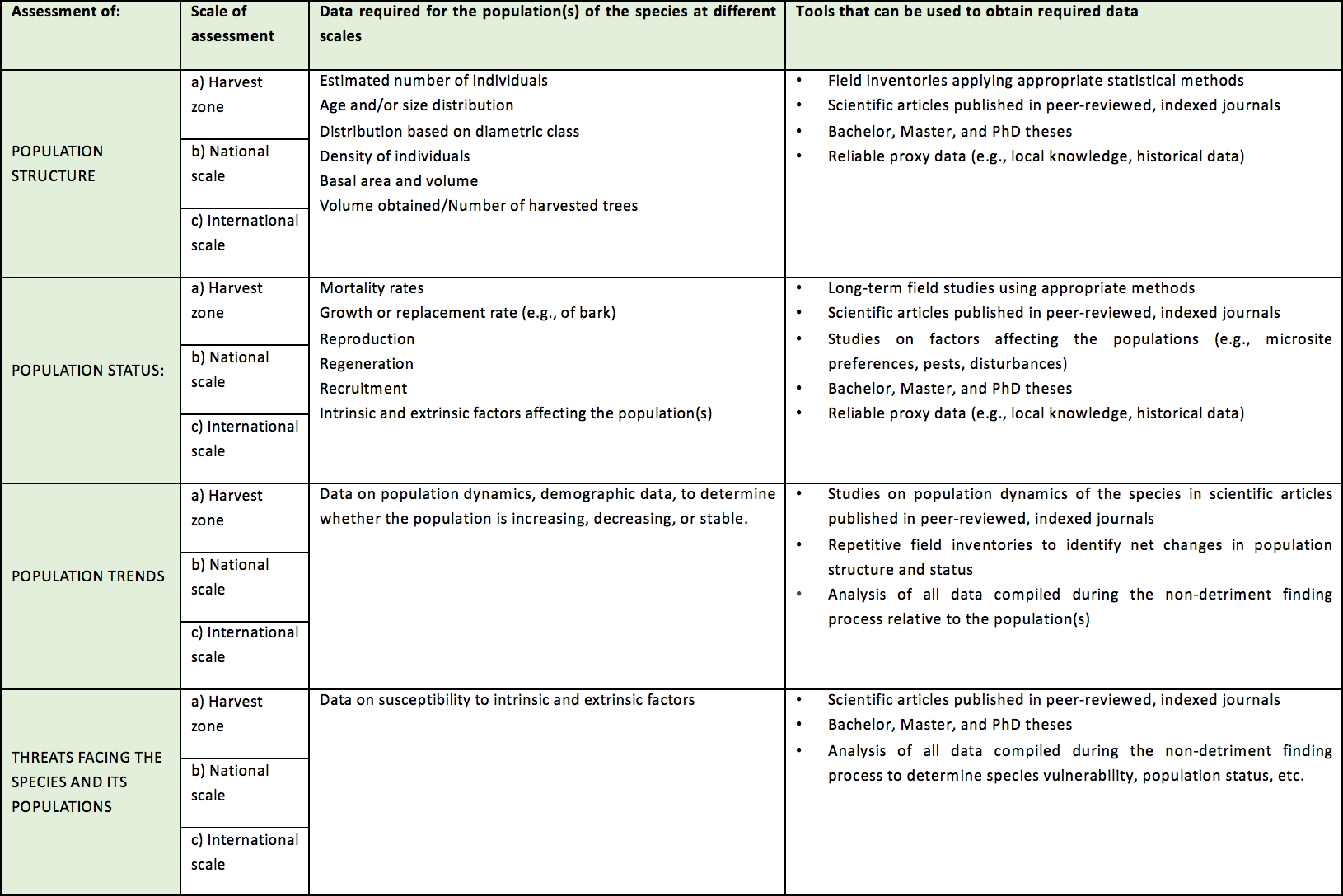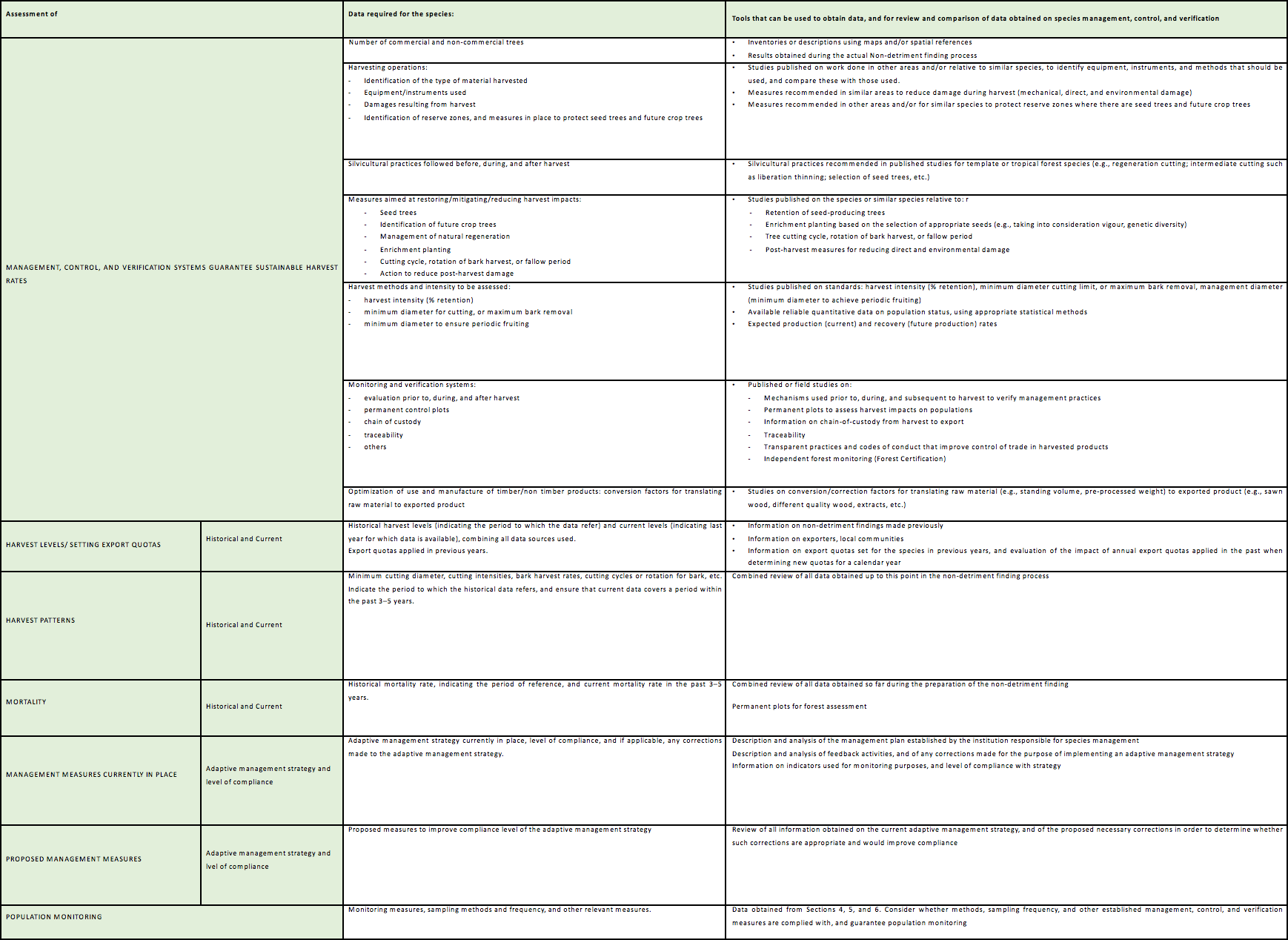Objective:
Define the type of specimen being harvested (bark, branches, leaves, fruits, seeds, other), and determine whether harvest is sustainable.
Recommendations:
Determine whether removal of the specimen may eventually lead to the death of the tree, as a result of damage, injuries, and/or diminished reproductive capacity. .
Consider whether the harvesting method is appropriate, and whether there is sufficient time between harvests for trees to recover.
Analyse whether the recovery period minimizes the impact of harvesting on the populations of the species.
Determine whether the resource is maintained in the population over time.
Answer:
NoProceed to next question.
Answer:
YES
Objective:
Consider the following essential elements:
Recommendations:
As you proceed with the preparation of the Non-detriment finding, you will gradually be able to complete the information for these elements.
If it is not possible to determine the above aspects, either wholly or partially, it is advisable to adopt a precautionary approach and make recommendations for any information gaps to be covered by means of field studies.
When harvested specimens are not whole trees, a positive non-detriment finding should provide reliable proof that harvesting is sustainable over time.
The Resolution recommends that:
Scientific Authorities should consider the volume of legal and illegal trade (known, inferred, projected, estimated) relative to the vulnerability of the species (intrinsic and extrinsic factors that increase the risk of extinction of the species.
Sustainability of the total harvest will usually be a necessary consideration when determining whether an export might be detrimental.
Objective:
Obtain and analyse national and international trade data by consulting, inter alia, up-to-date, reliable data sources.
Recommendations:
Use the following, and other information sources:
Consider the impact of known legal trade levels on the populations
Answer:
NoObtain and include information of the situation at a local level, if possible, and proceed to next question.
Objective:
Obtain information on illegal trade, if possible, and determine the reliability of information sources.
Recommendations:
Use the register of confiscations as a source of information.
Make separate analyses of confirmed data, and inferred, projected, or estimated data.
Whenever possible, consider the impact of known and estimated illegal trade levels on the populations
Answer:
Yes: Show the date obtained, and proceed with the following question.
No: Obtain and include information on the local situation, if possible, and proceed to next question.
Objective:
Verify or determine whether the species is vulnerable, and whether it is considered to be at high risk of extinction in the wild.
Recommendations:
Consult the IUCN Red List to check whether the species is registered as Vulnerable. The IUCN definition of Vulnerable is available in the Guide to the IUCN categories and criteria;
Consult national and/or regional red lists to find out whether the species is registered as Vulnerable.
Compile available data to examine and describe the species susceptibility to intrinsic and extrinsic factors that increase the risk of extinction; indicate data source, quality, and timeliness (e.g., registered, indexed publications, recent official national reports, organizations that registered such data). A species susceptibility may be a result of, but not limited to, any of the following factors:
Intrinsic factors
Extrinsic factors
Answer:
Yes: Show the data obtained, and bear in mind that a high level of vulnerability will mean a greater need for information in order to make the Non-detriment finding.
No: Obtain and include information on the local situation, if possible. Whenever species’ vulnerability is unknown, it is advisable to adopt a precautionary approach and make recommendations for any information gaps to be covered by means of field studies.
Include the data obtained, and proceed with the next question.
The non-detriment finding is based on resource assessment methodologies, which may include, but are not limited to, consideration of species biology and life-history characteristics.
Objective:
Obtain information about the species’ biological characteristics.
Recommendations:
Be informed of: growth rate, regeneration and reproduction strategies, recruitment rate, survival rate.
Specify the type of habitat used by the species, and if relevant, habitat specificity.
Explain the species’ role in the ecosystem.
Evaluate the significant elements of biology and life history, and specify method used.
Answer:
NoWhen the species biology and life history are not known, it is advisable to adopt a precautionary approach and make recommendations for any information gaps to be covered by means of field studies.
Include the data obtained and proceed to next question.
The Resolution recommends that:
The non-detriment finding is based on resource assessment methodologies, which may include, but are not limited to, consideration of the species range (historical and current).
Objective:
Determine actual distribution of the species at different spatial and jurisdictional scales, so that production and conservation areas can be identified.
Recommendations:
Suggested scales and tools that may be available to determine species’ distribution include:


Where relevant, use Openforis which is a set of free and open-source software tools that facilitates flexible and efficient data collection, analysis, and reporting.
Answer:
NoInclude the data obtained. If both historical and current distributions are known, it will be possible to determine whether there have been significant decreases in the area occupied by the species, or whether the species has remained stable or is increasing. Proceed to next question.
Include the data obtained. If both historical and current distributions are known, it will be possible to determine whether there have been significant decreases in the area occupied by the species, or whether the species has remained stable or is increasing. Proceed to next question.
The Resolution recommends that:
The non-detriment finding is based on resource assessment methodologies, which may include, but are not limited to, consideration of population structure, status, and trends (in the harvested area, nationally and internationally); threats.
Objective:
Determine population structure, status, and trends of the population(s) of the species at different scales, and threats.
Recommendations:
Suggested scales, data requirements, and tools to determine the population structure, status, and trends of the population(s) of the species at different scales, include:

Where relevant, use Openforis which is a set of free and open-source software tools that facilitates flexible and efficient data collection, analysis, and reporting.
Answer:
NoIf population structure, status and trends, and threats are unknown, it is advisable to adopt a precautionary approach, and make recommendations for any information gaps to be covered by means of field studies.
It should be borne in mind that, in keeping with the precautionary principle, and in case of any uncertainty about the conservation status of the species, or the impact of trade on its conservation, you should always act in the best interests of species conservation, and adopt measures proportionate to the expected risks for the species.
It is important to obtain information on population structure, status, trends, and threats at an international level. However, even if this information is not available, an NDF can still be made for an Appendix II species in countries where there is data available at the level of harvest zones and at a national scale. Knowledge of population structure, status, and trends, and of threats, will help predict the impacts of harvesting. In this case, once the data have been analysed, harvest standards and limits can be established to ensure sustainability.
The Resolution recommends that:
The non-detriment finding is based on resource assessment methodologies, which may include, but are not limited to, consideration of historical and current species-specific levels and patterns of harvest and mortality (e.g., age, sex) from all sources combined; management measures currently in place and proposed, including adaptive management strategies and consideration of levels of compliance; population monitoring
Implementation of adaptive management, including monitoring, is an important consideration when making a non-detriment finding.
Objective:
Based on sufficient knowledge of the distribution and population parameters, determine whether the management, control, and verification systems are appropriate for the populations of the harvested species, and whether harvest levels are sustainable, and reduce illegal activities and illegal trade.
Recommendations:
This will require an analysis of the data obtained for the population(s) of the species being harvested, and comparison with the results included in the Non-detriment finding process, or in published studies on the management of the species in question or similar species.
It is advisable to consult the material posted on certain websites such as:
ITTO Reduced impact logging; Tracking sustainability;
FAO Sustainable Forest Management (SFM) Toolbox
Suggested data for review, and tools that should be considered, include:

Where relevant, use Openforis, which is a set of free and open-source software tools that facilitates flexible and efficient data collection, analysis, and reporting.
Answer:
NoIf information on the management, control, and verification systems of the species population(s) is non-existent or insufficient, it is advisable to adopt a precautionary approach and make recommendations for any information gaps to be covered by means of field studies.
In keeping with the precautionary principle, and in case of any uncertainty about the conservation status of the species, or the impact of trade on its conservation, you should always act in the best interests of conservation of the species in question, and adopt measures that are proportionate to the risks predicted for the species.
Knowledge of the management, control, and verification systems of the population(s) of the species is essential in order to guarantee sustainable harvesting. In this case, following data analysis, it is possible to establish or enhance harvest standards, and control and verification measures in order to ensure sustainability, and foster adaptive management strategies and good compliance levels.
The Resolution recommends that:
The non-detriment finding is based on resource assessment methodologies, which may include, but are not limited to, consideration of conservation status.
It should be determined whether the species would be maintained throughout its range at a level consistent with its role in the ecosystems in which it occurs.
Objective:
Determine conservation status and whether there are safeguards in place to guarantee post-harvest conservation of the natural population(s) (including conservation of subpopulations within a population, if necessary), and to maintain the role of the species in its ecosystem.
Recommendations:
Obtain reliable, up-to-date information (indexed publications, red lists, forest maps, proposals to amend the CITES Appendices, field studies), and consider the combined data obtained throughout the Non-detriment finding process to determine whether there are safeguards in place for the following aspects, among others:
Determine the conservation status of the species at a local/subnational/national level, and where possible, at a regional level, by combining all data obtained, taking into consideration the following aspects, among others:
Answer:
NoIf the conclusion is negative: Apply precautionary measures, and In keeping with the precautionary principle, and in case of any uncertainty about the conservation status of the species, or the impact of trade on its conservation, you should always act in the best interests of conservation of the species in question, and adopt measures that are proportionate to the risks predicted for the species.
On combining all data obtained, it is concluded that the conservation status of the species is satisfactory throughout its range (at the different local, national, and subnational levels), and that the species is maintained at a level consistent with its role in the ecosystem. Further, there are strong safeguards in place to ensure that the situation remains stable at all levels, including regional and global levels. In this case, if the data obtained are reliable, quality, and up-to-date, the risk involved in making a positive finding will be very low.